The vintage toy world is interesting and full of possible riches. Whether you collect regularly or are just beginning, the appeal of real, nostalgic toys captivates you with their history, artistry, and original character. Finding a real antique toy might be difficult in a market full of copycat goods and knock-offs. Toy consumers have to be armed with the necessary skills to distinguish the real from the fake. Knowing the unique qualities of a real antique toy not only enhances the collecting experience but also helps to protect its worth. Along this road, one must learn to see the minute variations that characterize an original work. This book offers three essential techniques for toy collectors to identify real antique items properly.
1.Check the Toy's Materials and Construction Techniques
The original materials and artistry used in the manufacturing of authentic antique toys help them to stand out. Many historical objects were produced from wood, metal, rubber, and early types of plastic, unlike contemporary toys depending on synthetic materials and mass-production methods. Concentrating on the components can help you to determine if a toy originates from another age. Wood-made vintage toys often have a hand-carved look with obvious tool marks that provide a unique, handmade feel. Unlike mass-produced toys today, antique wooden toys were usually hand-painted, producing uneven surfaces that were much more difficult to recreate. Another often used media in the past was metal toys, which have a distinct weight and feel. Vintage metal toys were heavier, usually composed of steel or tin, unlike contemporary toys crafted of lightweight alloys. One famous example is the wind-up tin toys, often made in the middle of the 20th century. These items have a specific sound when wound up, and the tin is often engraved with elaborate motifs that accentuate their appeal. Early plastic toys were usually fashioned from a stiffer substance than modern flexible plastics.
2.Examine the Branding and Markings on the Toy
Examining the marks and branding of an antique toy is one of the best methods to verify it. Some toy manufacturers created unique trademarks, emblems, and labels throughout time that would be a hallmark of legitimacy. These markings are not only aesthetically pleasing but are often rather important for determining the age and source of the item. Toy buyers can often quickly identify vintage toy makers such as Fisher-Price, Tonka, and Mattel by their unique emblems and stamps. Investigating certain toy brands can help you acquaint yourself with the many emblems and stamps used by firms from different periods. Investigating certain toy brands can help you acquaint yourself with the many emblems and stamps used by firms from different periods. Moreover, the kind of writing and brand logo positioning reveals a lot about the background of the toy. A 1950s Fisher-Price toy, for instance, may feature a red-and-yellow logo using a typeface that was popular in that era. Conversely, a painting from the 1980s would probably have a more simplified, contemporary style. Many old toys often have patent numbers or model numbers etched into them, which allows one to track the item back to a certain release date.
3.Evaluate the Toy's Wear and Patina
The age and aging pattern of real antique toys are among their defining qualities. An antique toy's wear and patina not only add to its appeal but also are major indicators of its genuineness. Toys created decades ago have evolved a distinct style that newer replicas just cannot match over time. True antique toys will show real indications of usage that convey a tale, even if counterfeits may seem fresh and have been aged artificially. An antique toy could, for instance, display minor paint fading, scuff marks on surfaces from years of handling, or little dents and scratches, suggesting the toy has been loved and used. Because they show the history and character of the object, these flaws are often what increases the value of old toys. Particularly on metal toys, the patina might exhibit signs of oxidation or rust, therefore confirming their antiquity. Wood toys will frequently have a deeper, more subdued tone where the grain has absorbed oils from hands, and the surface may have been polished down from years of use.
Conclusion
Within the realm of toy collecting, finding an original item is like discovering a rare diamond. Examining the materials, branding, marks, and wear and patina of a toy can help you to evaluate its authenticity firmly. Real antique toys give a special link to history and carry the tales of earlier generations. By means of these techniques, you may reveal the actual worth of these ageless relics and guarantee that your collection stays as authentic as the memories it stands for.


